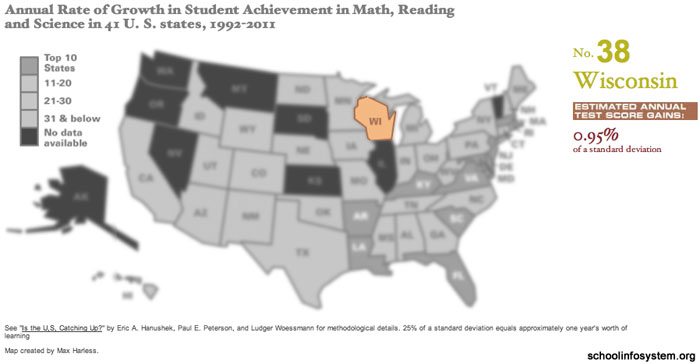
Eric A. Hanushek, Paul E. Peterson and Ludger Woessmann, via a kind Chan Stroman-Roll email:
“Yet when compared to gains made by students in other countries, progress within the United States is middling, not stellar (see Figure 1). While 24 countries trail the U.S. rate of improvement, another 24 countries appear to be improving at a faster rate. Nor is U.S. progress sufficiently rapid to allow it to catch up with the leaders of the industrialized world.”
“Meanwhile, students in Wisconsin, Michigan, Minnesota, and Indiana were among those making the fewest average gains between 1992 and 2011. Once again, the larger political climate may have affected the progress on the ground. Unlike in the South, the reform movement has made little headway within midwestern states, at least until very recently. Many of the midwestern states had proud education histories symbolized by internationally acclaimed land-grant universities, which have become the pride of East Lansing, Michigan; Madison, Wisconsin; St. Paul, Minnesota; and Lafayette, Indiana. Satisfaction with past accomplishments may have dampened interest in the school reform agenda sweeping through southern, border, and some western states.”
Underlying study: “Achievement Growth: International and U.S. State Trends in Student Performance“
Related:
- Student scores slip with new proficiency benchmarks by Erin Richards
The results: Only 35.8% of Wisconsin’s WKCE test-takers in third through eighth and 10th grade in fall 2011 scored proficient or better in reading, and just 48.1% scored proficient or better in math.
Compare that with March, when the state released 2011 WKCE results that showed 78% and 82% of students scored proficient or better in math and reading.
Under the new benchmarks, just 41.9% of white students scored proficient or advanced in reading, and 55.2% met that mark in math on the latest state test. Previously, more than 87% of white students were considered proficient or better in reading, and 84.3% were considered to have scored proficient or better in math in 2011.
As for the state’s black students – many of whom attend Milwaukee Public Schools – 13.4% are considered proficient or advanced in reading, down from 58.7% using the old grading scale.
Rep. Steve Kestell, a Republican from Elkhart Lake who chairs the Assembly’s Education Committee, called the revised picture of student performance a “necessary and long-delayed wake-up call for Wisconsin.”
“We’ve been trying to tell folks for some time that we’ve been looking at things through rose-colored glasses in Wisconsin,” he added. “It was a hard thing to communicate, and it was largely ignored. This is a new awakening.”
State Sen. Luther Olsen (R-Ripon), who chairs the Senate Education Committee, said: “We’ve known for years that our proficiency-cut scores are way below where they should be, and really, this shows that we have got to do a better job.”
Under the past decade of No Child Left Behind, Wisconsin had been criticized for having a more lenient bar for proficiency than other states. - Less than half of state’s students measure proficient under new national standards by Matthew DeFour:
Still, the new results should be a “smack in the face” for Wisconsin, said Adam Gamoran, director of the Wisconsin Center for Education Research at UW-Madison.
“It’s going to be a wake-up call,” Gamoran said. “It’s a more honest reckoning of where Wisconsin students stand relative to other students across the nation and relative to the goals we want for all of our students.”
The old results were based on whether students were meeting Wisconsin’s definition of being at grade-level, whereas the new results reflect more rigorous standards of what it means to be prepared for college or a career used for the National Assessment of Educational Progress, also known as the nation’s report card.
About 3,000 4th and 8th graders in Wisconsin take the NAEP every other year. In 2011, 32 percent of Wisconsin 4th graders scored proficient on NAEP’s reading test and 39 percent scored proficient on the math test.
The data released Tuesday marks the first time DPI has converted results of the state test, which more than 430,000 students in grades 3-8 and 10 take in the fall, to the NAEP benchmarks.
DPI won’t release recalculated results for individual schools and districts until the fall, when it also plans to release individual school report cards with ratings on a scale of 0 to 100.
Kim Henderson, president of the Wisconsin Parent Teacher Association, said parents pay closer attention to state test scores than NAEP scores, so the results could “bring up a lot of good questioning.” - State sets new, tougher standards for student tests by the Associated Press:
To get the waiver, Wisconsin had to develop its own accountability system in addition to teacher and principal evaluations, among other things.
The scores will be included on new school report cards to be released in the fall. How well individual students in grades 3-8 and 10 do on reading and math tests they take in November will be released next spring.
The new school report cards were developed in conjunction with Gov. Scott Walker, legislative leaders and others over the past year. They will include a numerical rating for individual schools from 0-100 based on student achievement, growth, graduation rates and closing of achievement gaps between different groups of students. The scores will generate an overall total that will place each school into one of five categories ranging from “Fails to Meet Expectations” to “Significantly Exceeds Expectations.”
“This new system will empower parents, allowing them to make education related decisions based on reliable and uniform data,” Walker said in a statement.
Sample report cards, without actual school data, are posted online to solicit feedback through Aug. 12. - Numerous notes and links on the oft-criticized WKCE, here.
- wisconsin2.org
